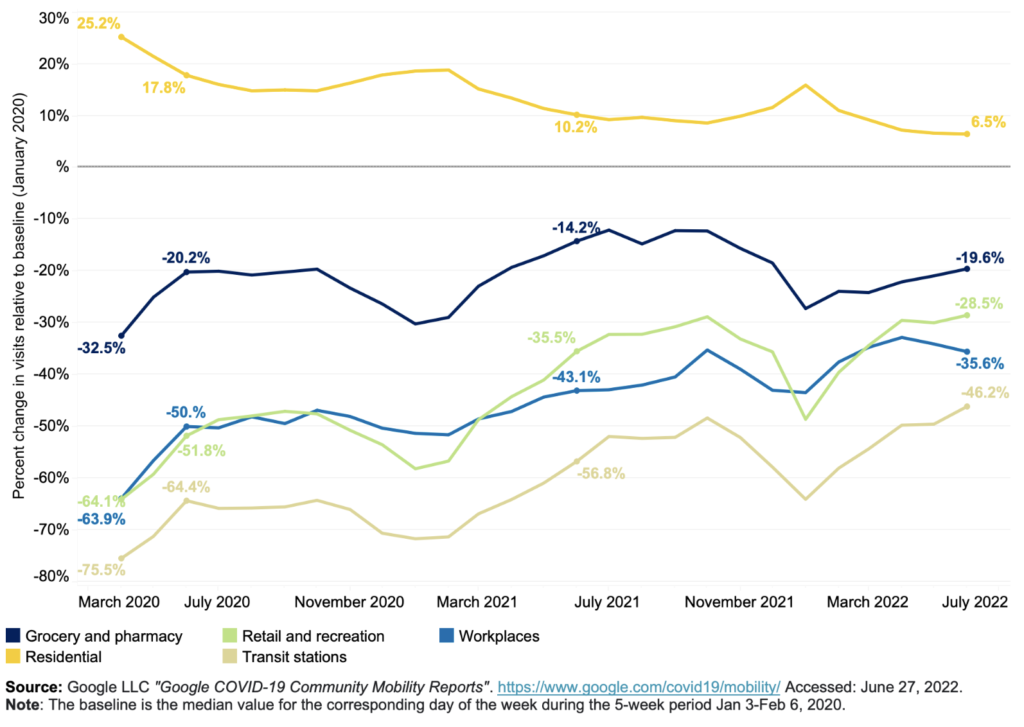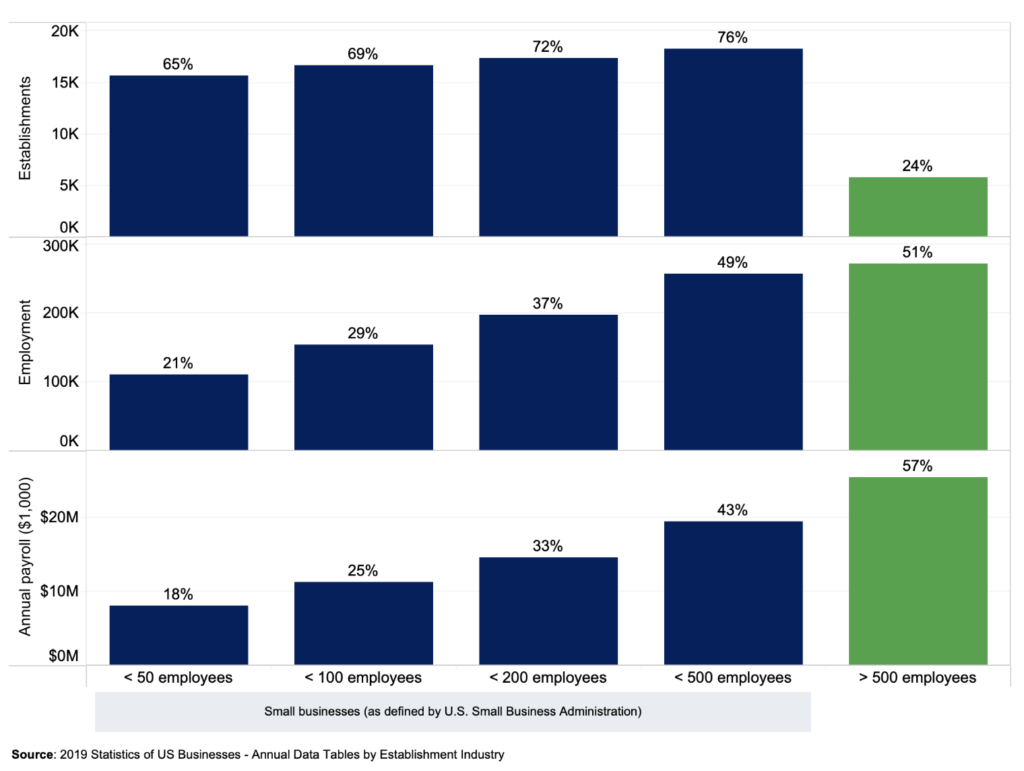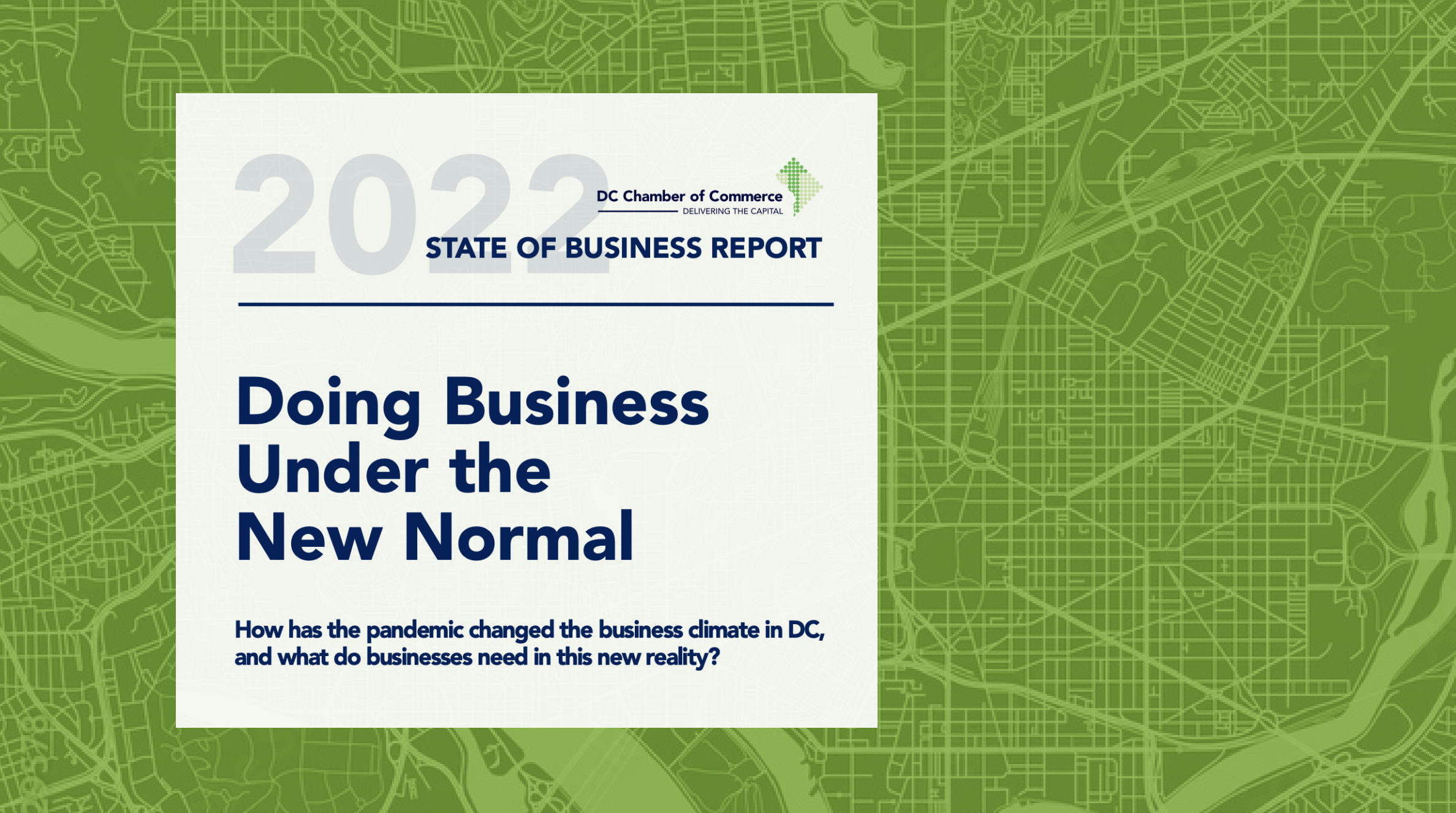
This is the Executive Summary of the 2022 State of Business Report: Doing Business Under the New Normal. This report was prepared for the DC Chamber of Commerce, with support received from the Office of the Deputy Mayor for Planning and Economic Development.
Other reports in this series:
- 2021 State of Business Report: Building Back
- 2020 State of Business Report: Pivoting from Pandemic to Recovery
- 2019 State of Business Report: Building a Competitive City
- 2018 State of Business Report: Towards a More Inclusive Economy
- 2017 State of Business in the District of Columbia: Twenty years of change since the Revitalization Act
It has been over two years since the beginning of the COVID-19 pandemic, and business activity has now settled into a new normal, significantly different from what it was before the pandemic.
Perhaps the most important change brought by the pandemic is the shift to remote work, with major impacts on the labor market, commuter and tourist activity, the demand for office space, and the location of economic activity in the city and in the region.
The 2021 State of Business Report provided both data and analysis of the impact of COVID-19 on the region, examining its toll on critical sectors and government tax revenues. This year’s report builds a better understanding of the post-pandemic city, with a special focus on small businesses: How has the pandemic changed businesses and entrepreneurial activity in DC? What trends are emerging in the labor market and how do they impact business operations? What are the greatest risks and opportunities in the post-pandemic era? And how have businesses’ needs evolved to this new reality?
In the past year, the District and country have made great strides in recovering from the pandemic’s initial impacts: health restrictions have been lifted, vaccines are widely available, booster shots have been administered, and many in-person activities have returned. However, the pandemic continues to alter day-to-day life in cities, and regular economic activity has yet to return to normal.
In fact, even in the third year of the pandemic, in large cities across the country, people are staying home more, and spending less time going out to restaurants, commuting to their workplaces, and shopping. This greater concentration of activity around homes, paired with the increased opportunities for remote work, has shifted migrations patterns with residents increasingly moving out of large, high-cost metropolitan areas to smaller, lower-cost locations. The District is experiencing the consequences of this shift.
Figure 1. Mobility trends in the District of Columbia

These behavior patterns and the consequent demographic shifts offer some insight into how the pandemic has changed the local economy: economic activity is shifting from job-dense areas to residentially dense areas. If this continues, there are implications for the District’s businesses, especially small businesses that tend to locate in physical proximity to their customers. This report identifies the emerging trends that local businesses owners will likely have to respond to in a post-pandemic city in order to remain successful.
Emerging worker preferences are breaking the relationship between where people live and work.
After working from home for over a year, workers with occupations that can be performed remotely continue to favor remote work, even as offices reopen. As of July 2022, the Survey of Working Arrangements and Attitudes finds that, nationwide, the percentage of paid full days worked from home has stabilized around 50% among workers who hold remote-eligible jobs. This compares to only 5% of paid full days worked from home pre-pandemic. With this added flexibility, workers no longer need to live near their workplaces. This is particularly concerning for high-cost cities that have historically served as commuter hubs.
In the District of Columbia, remote work is common: a larger share of jobs in the Washington metropolitan area can be worked remotely compared to the rest of the country. An average of 60% of workers in large office buildings have continued to work from home as of July 2022. As commute times become a less important factor, more DC residents have chosen to relocate to areas with lower housing costs and a lower cost of living. In fact, between July 1, 2020, and July 1, 2021, the District lost 20,043 residents, largely due to domestic out-migration. This is the largest single-year population loss for DC since 1992. While recent Census data can be unreliable due to a higher undercount, other data sources, such as the Internal Revenue Service (IRS) and U.S. Postal Service (USPS) change of address data also confirm a population loss.
This threat to the District’s base of workers and residents poses new challenges for the city’s small businesses, particularly those that primarily serve office workers downtown. With fewer office workers commuting, many office buildings remain largely vacant. Across the District, office vacancy has reached historic highs of 15% as of Q2 2022, which has resulted in disproportionate and sustained impacts on small businesses located downtown.
With the changing labor market, local small businesses may be left behind in attracting new talent.
One bright spot in the past year has been the labor market’s recovery: more residents have reentered the labor force, signaling future growth in employment, and pulling down the unemployment rate to nearly pre-pandemic levels. Despite this positive outlook on resident employment, as of June 2022, total employment in DC remains 38,400 jobs below the job count in February 2020 (805,000), and service-based industries continue to lag office-based industries. As a result, high-wage jobs have been replacing low-wage jobs. It is unclear whether those in lower-wage occupations are leaving the city or leaving their industry.
Regardless, this observation makes it difficult for many small businesses to find and attract new talent. Despite record levels of job postings and stabilized levels of layoffs and discharges, more people are quitting their jobs, possibly in search of better benefits, flexibility such as remote work, or increased pay as inflation rises. This dynamic creates added pressure for small businesses to keep up in the job market because they are forced to compete with companies that have greater resources.

Small Businesses Add Value to the District’s Economy
Prior to the pandemic, small businesses were essential to the District’s economy—thus their ability to recover from the pandemic’s impacts is critical to the city’s economic growth in the future. According to the U.S. Small Business Administration’s definition of small businesses (those with less than 500 employees), 76% of establishments in DC (or a total of 18,224) are small businesses. These businesses account for 49% of the city’s employment and 43% of annual payroll. Even businesses with much less than 500 employees have a strong impact on the District’s economy; businesses with less than 50 employees account for 20% of the city’s employment.
Figure 2. Small business establishments, employment, and annual payrolls as a share of all business establishments in the District of Columbia

While it is difficult to get an exact measure of how many businesses permanently closed during the pandemic, the data show that on net, the District has had an increase in establishments since the onset of the pandemic. This indicates that while the pandemic has presented numerous challenges to local businesses, the city remains an attractive place to do business.
Despite these challenges, the District’s small businesses have been resilient. Some have already found ways to adapt, boosting the economy in the city’s residential and mixed-use neighborhoods.
Businesses in DC are particularly vulnerable to some of the changes emerging from the pandemic because they operate in a small, open economy. Their customer base could just as easily live or work in neighboring urban jurisdictions, making it essential to retain existing and attract new residents in a post-pandemic environment. In response to this challenge, many establishments have moved closer to their customers, boosting the economy in the city’s residential and mixed-use neighborhoods.
USPS change of address data show the exodus of businesses from downtown DC, paired with a net increase in businesses in the city’s residential areas. Comparing year-over-year data reveals that net domestic outmigration of business establishments (address changes out of DC minus address changes into DC) is six times greater than what we saw in a typical year before the pandemic. However, this loss in existing businesses is paired with a continued uptick in entrepreneurial activity. As a result of a surge in business applications across the District, there was a net increase in total private establishments by 4,465 between 2019 and 2021, an 11% increase.
Additionally, data released by the U.S. Bureau of Labor Statistics based on a June 2022 survey of businesses across the country show that a larger share of private sector businesses in DC adopted telework, reduced their office space, and moved their offices, compared to the private sector establishments across the country at-large.

Chamber of Commerce Member Voices: Why DC?
“Because DC is simultaneously my hometown, an incredible local city, a national capital, and a global seat of influence. The mix of hyperlocal neighborhoods and national gathering places, of great people and global connection. There is no place like it and no place I’d rather raise my family and run my business.”
Michael Akin, President, LINK Strategic Partners
“Washington, DC is a world-class city that is surprisingly under-retailed. I felt this whopping leakage combined with DC’s strong ‘buy local’ culture made it fertile ground for homegrown entrepreneurship, and I wanted to be a part of that ecosystem.”
Andre Byers, Founder & CEO, Near Delivery
“We have worked in the area for several years and are very familiar with the restaurant industry. I feel there is a lot of information and help on what’s needed to open a business in the District making the process easier.”
Geraldine Mendoza, Director of Operations, Taqueria Xochi
“Opportunities that DC gives, like tourism and the knowledge that DC people have about food from other countries, were the main reasons that pushed us to open in DC.”
Matteo Venini, Chef & Co-Owner, Stellina Pizzeria
This resilience paired with support from city leaders to respond to emerging needs of small businesses will encourage a strong recovery from the pandemic.
The District’s local businesses—and especially small businesses—must now adapt to future expectations as they continue to recover from the pandemic’s initial impact. In the post-pandemic environment, new stressors for businesses will include attracting and retaining new talent, adapting to the use of new technologies, and, for those that are service-based, retaining foot traffic or adapting operations to account for shifts in economic activity across the city. The District can work to support these businesses by ensuring the city remains an attractive place to live and do business, thus maintaining a strong talent pipeline. As new businesses emerge in the wake of the pandemic, the city will need to focus on reforming the regulatory environment to create a place that is friendly to both new and existing establishments.

This is the Executive Summary of the 2022 State of Business Report: Doing Business Under the New Normal. This report was prepared for the DC Chamber of Commerce, with support received from the Office of the Deputy Mayor for Planning and Economic Development. Read the full report [PDF].
